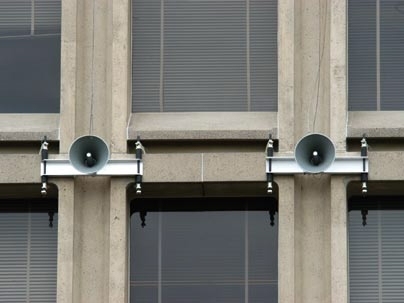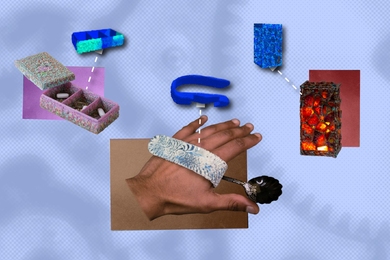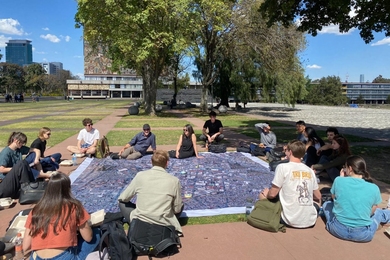The Green Building is humming, and not just from activities in its labs and offices and classrooms. Thanks to Carrie Bodle (S.M. 2005), Building 54 has been turned into a giant speaker, resonating with sounds from the upper level of Earth's atmosphere.
Every day, through Friday, Sept. 16, from 12-1 p.m., "Sonification / Listening Up," a large-scale sound installation using 35 speakers installed on the south facade of the building, will broadcast an abstract sound collage generated from research data collected in the ionosphere.
"Sonification / Listening Up," is a perfect example of collaboration between the arts and sciences, says Bodle. The project, she maintains, is "exemplary for MIT's interests in creating an environment in which the arts merge with technology to create inspirations for artists and scientists."
Conceived in collaboration with Philip Erickson of the Atmospheric Sciences Division at MIT's Haystack Observatory, "Sonification / Listening Up" makes it possible to listen in on the ions and electrons in the upper atmosphere as they are affected by the interaction between the Earth and the sun. The result, says Bodle, is a "sonification of the interplay of sun winds with the Earth's atmosphere," a continuous interaction that takes place some 60 miles above the ground.
Bodle's impetus for the project was hearing a segment on National Public Radio's "The Next Best Thing" about British astro-seismologists who listened to the stars by extracting radio waves from frequency, amplitude and phase. "Different stars, such as the sun or red dwarfs, made different sounds," said Bodle, who found herself fascinated by the process.
After meeting with Haystack's radio astronomers, Bodle connected with Erickson, whose work also involved frequency, amplitude and phase of the stars.
Sponsored by the National Science Foundation, Haystack is currently the only observatory in the continental United States that uses ground-based sensing to map changes in the makeup of the ionosphere. Such changes, especially during disturbed periods, can affect the precision of GPS technology and other man-made long distance and satellite transmissions.
The temporary system of 20-inch speakers was professionally installed in seven tiers up the face of the building. David Barber, assistant director of safety, and Dave McCormick, supervisor of facilities, were heavily involved with the logistics and safety concerns of installing a public art project of this scale, says Bodle, who notes that the project, which had been planned for May, was postponed to address these concerns.
The installation has been funded by the Office of the Provost, Vice President for Research and Associate Provost, Associate Provost for the Arts, Department of Architecture, the Visual Arts Program, and the Council for the Arts at MIT.
A closing event titled "Sound Off" will be held on Friday, Sept. 16, from 5-7 p.m.
For more information, e-mail Carrie Bodle at cbodle@mit.edu.






